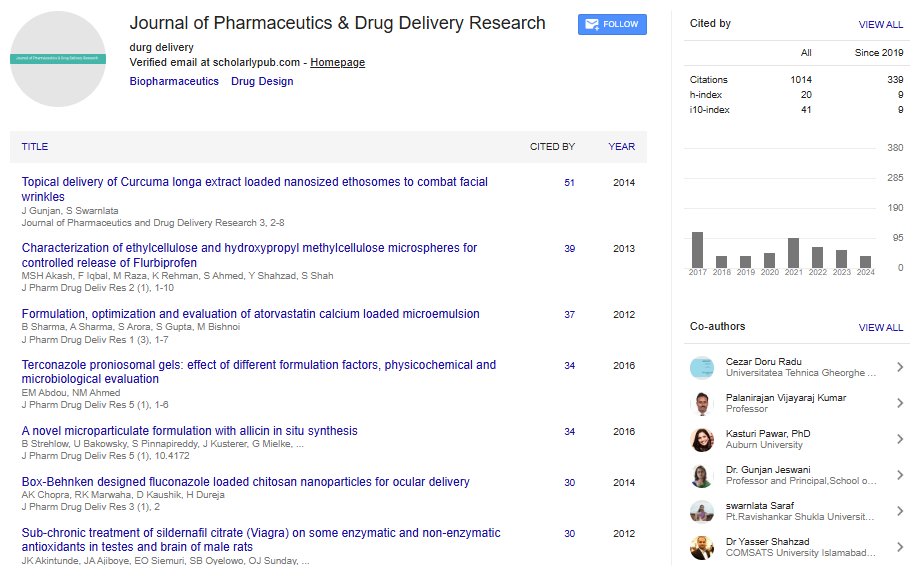Commentary, J Pharm Drug Deliv Res Vol: 13 Issue: 6
Advances in Drug Stability Testing: Novel Technologies and Future Directions
Liang Zhang*
1Department of Pharmaceutical Sciences, Shenyang Pharmaceutical University, Shenyang, China
*Corresponding Author: Liang Zhang,
Department of Pharmaceutical Sciences,
Shenyang Pharmaceutical University, Shenyang, China
E-mail: zhan.lian@gmail.com
Received date: 28 October, 2024, Manuscript No. JPDDR-24-154176;
Editor assigned date: 30 October, 2024, PreQC No. JPDDR-24-154176 (PQ);
Reviewed date: 13 November, 2024, QC No. JPDDR-24-154176;
Revised date: 20 November, 2024, Manuscript No. JPDDR-24-154176 (R);
Published date: 29 November, 2024, DOI: 10.4172/2325-9604.1000314
Citation: Zhang L (2024) Advances in Drug Stability Testing: Novel Technologies and Future Directions. J Pharm Drug Deliv Res 13:6.
Description
Drug stability is a pharmaceutical product's capacity to maintain its physical, chemical, medicinal and microbiological characteristics within the prescribed parameters across its entire lifespan. It is an important aspect of drug development and production, influencing efficacy, safety and compliance with regulatory standards. Ensuring drug stability involves a thorough understanding of the factors affecting it, the mechanisms of degradation and the methods employed to enhance and evaluate stability.
Importance of drug stability
Drug stability is essential for several factors:
Efficacy and safety: Instability can lead to reduced potency, rendering the drug ineffective or unsafe.
Patient compliance: Stable drugs ensure consistent dosing and therapeutic outcomes.
Regulatory compliance: Organizations such as the Food and Drug Administration (FDA) and European Medicines Agency (EMA) require evidence of stability to approve drugs for market release.
Economic impact: Improved stability reduces production losses, recalls and storage costs.
Factors influencing drug stability
Some of the general aspects affecting drug stability include. High temperatures accelerate chemical degradation and microbial growth. Moisture can cause hydrolysis, crystallization changes or microbial contamination. Ultraviolet and visible light may induce photochemical degradation. Oxidation can decrease drug efficacy and safety. Some molecules, such as esters and amines, are more susceptible to hydrolysis or oxidation. Amorphous solids may degrade faster than crystalline forms. Many drugs exhibit optimal stability within a specific pH range. Glass, plastic and metal can interact differently with the drug and its environment. Inadequate barriers can expose the pharmaceutical to the elements and contaminants. Improper storage can accelerate degradation.
Mechanisms of drug degradation
The most prevalent measures of drug separation are described as follows.
Chemical degradation: Breakdown of compounds due to reaction with water. Common in esters, amides and lactones. Reaction with oxygen or peroxides, frequently catalyzed by light or trace metals. Decomposition due to light exposure, affecting drugs including riboflavin and nifedipine. Conversion of one isomer to another, affecting drugs with symmetrical centers.
Physical degradation: Transition between different crystalline forms affecting solubility and bioavailability. Loss of amorphous form, impacting dissolution rates. Instability in emulsions and suspensions.
Microbiological degradation: Growth of bacteria, fungi or molds can degrade the drug or produce harmful byproducts.
Future directions
Emerging methods including Raman spectroscopy and mass spectrometry enhance degradation pathway analysis. Artificial intelligence and machine learning are being used to predict stability under various conditions, reducing the need for extensive testing. Sustainable materials are being developed to balance stability needs with environmental implications. Stability testing for individualized therapies will require new structure and technologies.
Challenges in drug stability
Modern drugs, such as biologics and combination therapies, present unique stability challenges due to their complexity. Drugs need to remain stable in a variety of climates, ranging from dry regions to humid tropics. Ensuring stability in the supply chain is essential to deal with illegal and inadequate drugs. Different regions have unique requirements, complicating global compliance.
Stability testing
Stability testing is a regulatory requirement and provides data to establish a drug’s lifespan and storage conditions. It includes real-time and immediate studies.
Physical stability: It examines appearance, colors, smell and texture.
Chemical stability: Analyses drug substance and degradation products using techniques such as high-performance liquid.
Microbiological stability: Ensures sanitation and absence of microbial contamination.
 Spanish
Spanish  Chinese
Chinese  Russian
Russian  German
German  French
French  Japanese
Japanese  Portuguese
Portuguese  Hindi
Hindi 
